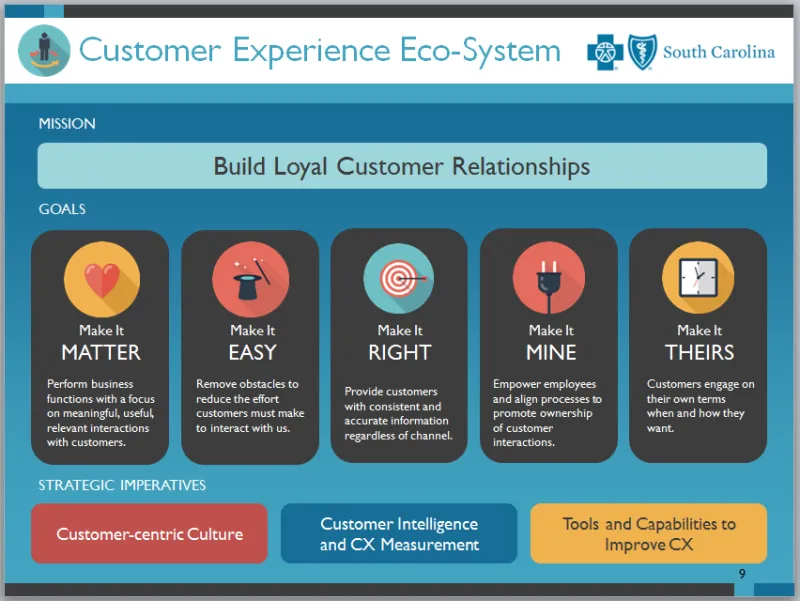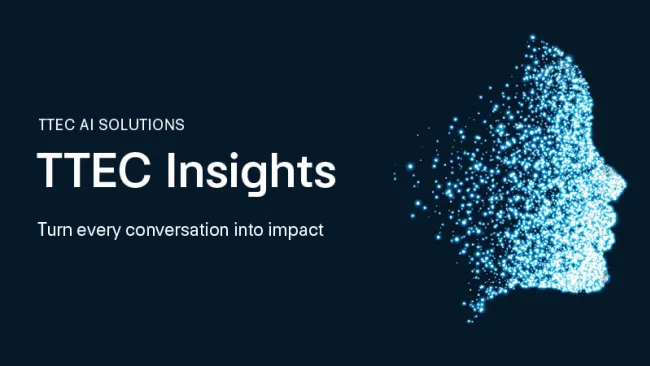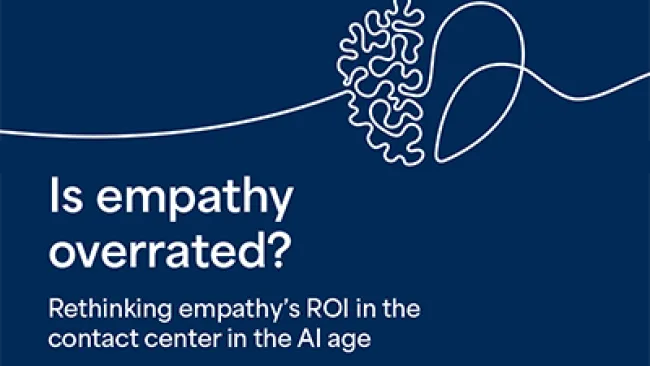“Health plans belong to people. People don’t belong to plans.” This simple statement says a lot about the mindset shift happening in the health insurance industry. BlueCross BlueShield of South Carolina is in the midst of this shift, entering its fifth year of strategic customer experience transformation. During the process, the organization learned that culture change and adaptability are the basis of any lasting transformation, says Customer Experience Officer Vicki Whichard.
“The shift to [the Affordable Care Act] reinforced that the customer experience is vital,” Whichard says. “It’s an entire culture change, with support from the top. It’s a huge grassroots effort.” A 15-year veteran of the company, she started four years ago in her current role. The company has served South Carolina residents for more than 60 years and has more than 12,000 employees. Operations are divided across several lines of business and market segments, which can make it challenging to ensure consistent decisions regarding customers.
As customer experience grew as a strategic priority for BlueCross, so did Whichard’s team. Her current team of five customer experience consultants works across the lines of business to help with customer insights, speech analytics, internal and external communication strategies, and culture change. “We’re advocates for the customer, but we balance that with business needs through people, process, and technology alignment,” she says. “Consumers see us as one BlueCross, not each wing of the organization. So we can’t interact as separate entities.”
Moving from a transaction-based culture to one of customer focus is a hefty challenge for nearly all health insurers. Even the idea that members are customers is a traditionally foreign concept. That’s why the customer experience team created fun yet informative ways to engage all employees to help drive new customer-focused understanding. The team made internal videos for employees featuring an animated spokesperson named Tony, who walks through common situations from a customer point of view. In one video, Tony visits different areas of the company and explains how each—from the mailroom to the C-suite—has an impact on customer service. And last year the company built a “listening room” complete with ear buds and popcorn, and invited all employees to listen in on member calls. “It was amazing,” Whichard says. “Many of them had never interacted with members before. It made them connect what their job is to the customer experience.”
One of the biggest projects of the company’s transformation has been the development of an enterprisewide customer experience ecosystem. The organization redefined its mission to build loyal customer relationships through five goals: make it matter, make it easy, make it right, make it mine, and make it theirs. Each goal is enabled by customer-centric culture, customer intelligence and analytics, and tools to improve customer experience (see Figure 1).

Cross-functional teams meet every two weeks to talk about how the ecosystem is being implemented and share stories of what works and what doesn’t. With a well-defined ecosystem backed by achievable goals, employees now have a shared understanding of what the customer experience is all about, and how they can play a role in building relationships, Whichard says. The key is investing in employees to create innovation in all areas of the company, not just customer experience. The company recently won awards for its career advancement program and customer service representative training program.
Planning for the digital future
While the first five years of BlueCross’ CX transformation was about enabling a consistent, customer-focused culture, the next priority is to enable mobile and digital strategies for its changing customer base. Although right now 86 percent of customer interactions occur in the call center, that won’t always be the case. “We’re getting ready for 2020, when more than 50 percent of customers will be Millennials,” Whichard says. “They won’t have many claims, and they won’t use the computer or call the contact center. You have to look at the future of the business and how to prepare for it.”
The company is looking at more proactive engagement strategies and new ways to interact. For example, this year BlueCross started a pilot project of adding stickers to its identification cards for new members, similar to ones found on credit cards. When members call to verify their card, they are asked to opt-in to receive text alerts about benefits and health-related messages. They receive messages like flu shot reminders, with the goal of eventual one-to-one interactions based on individual member information. Whichard reports positive engagement so far.
The team is starting to focus on mobile interactions across the board. “More than 74 percent of our customers call from a cell phone,” Whichard says. In South Carolina, more economical mobile devices are widely used compared to desktop computers, she adds.
With these insights, BlueCross is building a business case for mobile responsive website enhancements and mobile app development. But the company is careful not to build anything just for the sake of technology. “We don’t want to take our mobile site and turn it into an app,” Whichard says. “We’re trying to get to a point where we can offer something new and relevant [via an app].” The company is exploring tools such as ID card access, mobile payments, price comparisons, and telehealth features.
Her statement “health plans belong to people” refers to the idea that customers should be at the center of the organization and considered before making any plans, digital or otherwise. BlueCross has brought the concept to life by keeping one customer login for all website interactions, re-writing letters in more simple language, and creating a master calendar of customer outreach to avoid over-communication and to align all lines of business. The company also redesigned its call center performance scorecard, moving away from average handle time to focus on NPS, customer satisfaction, first call resolution, and other customer experience metrics.
Customer insight leads the way
Advanced customer insight is necessary when making these types of decisions. Voice of the customer is paramount to nearly every initiative, and BlueCross has won numerous awards for its programs. The company records and uses speech analytics for 100 percent of the calls that come into its 10 call centers. The customer experience team also conducts focus groups to learn about customer needs. “That insight and providing actionable information is what we focus on,” Whichard says. For example, research uncovered that customers want information about pricing and comparisons at the point of purchase—namely at the physician’s office. They want to know what the experience is like at certain offices, plus costs and benefits of different procedures so they can make informed decisions.
As a result, BlueCross now publishes reviews of physicians on its website, based on member visits. Members can review the physician as well as the facility. The reviews are moderated to prevent the release of personal health information, but otherwise are freely posted. The physician is notified and can respond as well, which closes the loop for a more rewarding experience.
No fluffy stuff here
With so many new initiatives, it can be hard to prioritize. Whichard says that data will guide the way. Listen to the voice of the customer. Where there are complaints, there are opportunities to improve the customer experience while also gaining internal efficiencies. It’s also important to get lines of business to leverage shared capabilities as much as possible. “Customer experience can be seen as ‘fluffy stuff,’” Whichard admits. Often customer experience leaders have to prove the value of what they do. By shifting the conversation to one of value—for both the customer and the company—it makes it easier for the rest of the business to get behind change.
Whichard says customer transformation requires passion, tenacity, and commitment to customer centricity. She adds that it often means having a thick skin to go to bat for the customer and stay positive and on message even during bumps. “It’s a very rewarding job,” she says. “You have to have a passion for it. To be successful, it takes the whole company, not just one department.”















